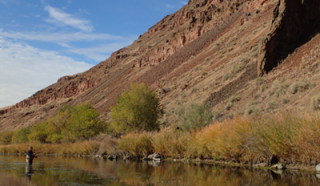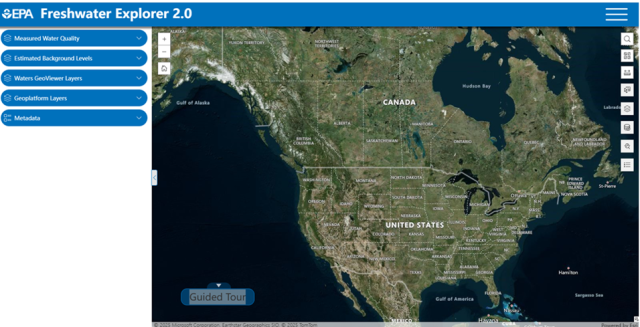Freshwater Explorer

On This Page:
Access Freshwater Explorer (Version 2.0)
A tool for exploring the water quality of freshwater resources
EPA's Freshwater Explorer is an interactive web-based mapping tool for water quality parameters of freshwater streams, lakes, and groundwater wells in all 50 U.S. states, Puerto Rico, and the U.S. Virgin Islands. It includes both observed data points and estimated background concentrations to make it easy to identify areas where water quality has been impacted by human activities. It can be used by citizens and non-governmental organizations, to better understand national and local water quality issues and to provide water quality information to help federal, state, territory, Tribal, and local partners make decisions about freshwater resources. Users can add spatial layers to explore associations between water quality measurements and natural and human geographical factors and any of the more than 10,000 other available data layers accessible from the GeoPlatform that may affect water quality in the United States.
Freshwater Explorer 2.0, the clean-up procedures, and curated data layers were designed so that states, Tribes, businesses, industries, and everyday American citizens can leverage national data sets to better enable environmental protection empowered by federalism. The work achieves this goal by 1) providing semiautomated clean-up procedures to harmonize data from state and federal sources, 2) providing curated data sets so states are not limited to only their own data, and 3) providing a mapping tool to visualize different kinds of data. These data may be used to characterize background water quality to develop stressor-response relationships or evidence for condition, causal, and risk assessments after taking into consideration application specific data quality needs. These data layers allow states and industry to download the data for analysis, strategic planning, and decision making.
Compatibility and Availability
The Freshwater Explorer is map-centric and mobile-friendly. It works on all screen sizes, from desktop computers and tablets to mobile phones. The application can be downloaded to a third-party PC with full access to modify it with an ArcGIS account.
Preferred citation: Wharton C., Newcomer-Johnson, T., Cormier S. 2025. U.S. EPA Freshwater Explore V2. United States Environmental Protection Agency. April 2025. https://arcg.is/Xfneu
Capabilities
Freshwater Explorer Version 2.0 includes summary statistics for 11 commonly sampled water quality parameters for approximately 289,000 stream locations, 10,000 lakes, and 50,000 groundwater wells. To date they are:
- alkalinity
- ammonia
- calcium
- chlorophyll a
- chloride
- conductivity
- organic carbon
- pH
- sulfate
- total phosphorus
- total nitrogen
Users can now perform complex searches and more easily add or download data. They can also modify a customizable map and pull in data from other EPA sources, such as ECHO (Enforcement Compliance History Online), ATTAINS (Assessment Total Maximum Daily Load [TMDL] Tracking and Implementation System), StreamCat and LakeCat.
Water Quality Portal (WQP) data from Water Quality Exchange (WQX)
The Freshwater Explorer 2.0 effectively curates and summarizes the vast array of water quality data records available in the Water Quality Portal (WQP), which encompasses hundreds of millions of entries. Over 500 federal, state, Tribal, and other partners have contributed their data to the WQP through the Water Quality Exchange.
The tool was developed to help users visualize water quality datasets with color-coded displays. EPA compiled and curated data from the WQP using Tools for Automated Data Analysis (TADA). EPA further curated the TADA output, removing some and tagging very low or high values submitted by contributors. However, data still include undetected errors of magnitude and location, and therefore, the tool is most appropriate for performing screening-level analysis. Users should assess the suitability for their specific applications.
In addition to observed station values for each variable, the estimated background levels (25th centile of median measurements by level 3 ecoregions (Omernik, J. M.; Griffith, G. E., 2014) were estimated for the 11 datasets.
Data and Metadata
EPA’s Freshwater Explorer 2.0 contains:
- Measured water quality parameters - WQP: Observational data from EPA’s Water Quality Portal (WQP), the nation's largest source for water quality monitoring data, cooperatively sponsored by the United States Geological Survey (USGS), the EPA, and the National Water Quality Monitoring Council (NWQMC).
- Estimated Background Levels
- 25th centile of medians: monitoring data from the WQP between 2000 to 2023 by level 3 ecoregions.
- Random Forest Modeled Background for Conductivity: Monthly average of empirically modeled conductivity as it would occur if water quality was minimally influenced by anthropogenic sources (Olson and Cormier, 2019)
The most basic use of the EPA’s Freshwater Explorer is to check whether observed levels are greater than background or nearby locations. Furthermore, users can look for associations between observed water quality and land cover to begin to understand why levels may be higher than expected. From there, visualizations can vary depending on the interest of the user. For example, users may choose to compare point sources with estimated background and relationships among other water quality parameters (e.g., nutrients, chlorophyll-a), potential and actual sources (e.g., land cover and toxic release records), and demographics (e.g., population density). This combination of information can be useful for states working with communities and regulated entities to find the right balance of protection and use of freshwater resources. The background is estimated and may need to be calibrated for local conditions.
U.S. EPA Freshwater Explorer - Quick Guide
Related Resources and Citations
- EPA’s Water Quality Portal
- Water Quality Exchange
- Tools for Automated Data Analysis (TADA)
- National Aquatic Resource Surveys (NARS)
- How's My Waterway
- ESRI, 2014. ArcGIS Desktop: Release 10.2.2. Environmental Systems Research Institute, Redlands, California.
- McKay, L., Bondelid, T., Dewald, T., Johnston, J., Moore, R., Rea, A., 2012. NHDPlus Version 2: User Guide. National Operational Hydrologic Remote Sensing Center, Washington, DC.
- NASA, 2019. Moderate Resolution Imaging Spectroradiometer (MODIS) satellite data. Available at: https://modis.gsfc.nasa.gov/data/
- Omernik, J. M.; Griffith, G. E., 2014. Ecoregions of the conterminous United States: evolution of a hierarchical spatial framework. Environmental. Management. 54 (6), 1249−1266. doi: https://doi.org/10.1007/s00267-014-0364-1
- U.S. Environmental Protection Agency (U.S. EPA), 2016. STORET. Available at: https://www.epa.gov/storet/
- U.S. Geological Survey (USGS), 2016. National Water Information System. Available at: https://waterdata.usgs.gov/nwis
- Olson, J.R. and Cormier, S.M. 2019. Modeling Spatial and Temporal Variation in Natural Background Specific Conductivity. Environmental Science & Technology. DOI: 10.1021/acs.est.8b06777. www.ncbi.nlm.nih.gov/pmc/articles/PMC7153567

